Fit to ride is a bit of a cliché, and there a lots of self-appointed fitness experts out there with programs but how many of them are in the dressage world’s top ten? This new DressurFit is designed by Jessica von Bredow-Wendl and her brother, Benni and is tailored to the needs of each individual rider.
We asked Rebecca Ashton to road test it…
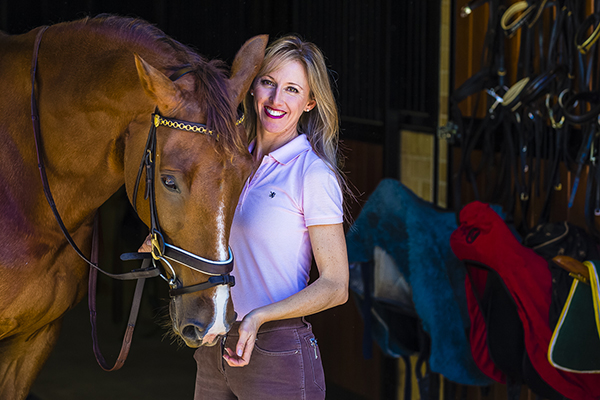
When I’m not riding horses or helping riders, I can usually be found teaching pilates or working out myself – and in between all that, I like writing stories and taking photos – so it’s fun to come across a story that unites all my interests in one lovely bubble. I also love a challenge and when that challenge comes from one of the world’s most elegant dressage riders – Jessica von Bredow-Werndl – to see how I shape up on a fitness program that she and her brother Benni, have been instrumental in designing, specifically to help riding position and rider effectiveness, it’s let me at it…
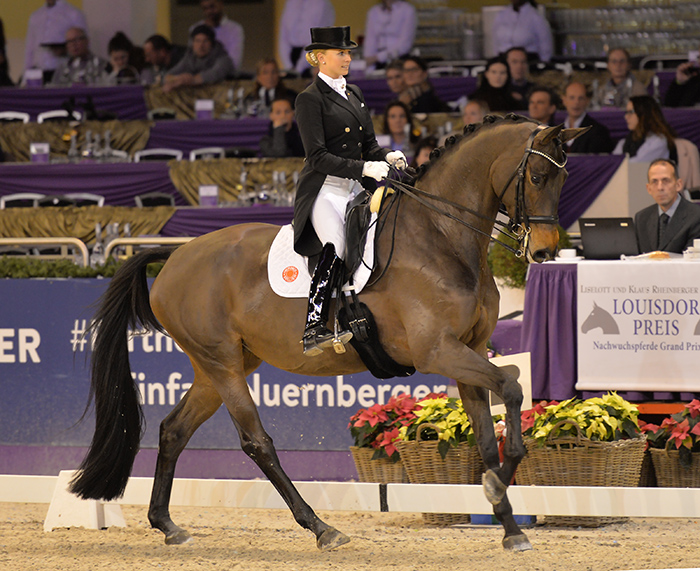
Jessica and her world number three – Dalera (Photo Kenneth Braddick dressagenews)
In between road testing that DressurFit program, I’ll be talking to Jessie about the programme itself.
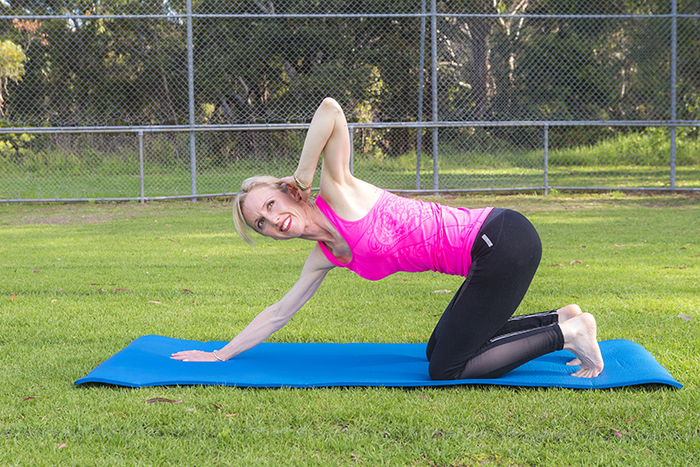
Rotation
But first let’s get started with the ‘Rotation’ Exercise. My first DressurFit test suggested that this exercise was one of my ‘homework’ exercises – yes, as you will find out when we talk with Jessie, you get your own personalised exercises as well as the group workouts.
Rotation helps improve the movement in my thoracic spine. I needed some extra work on my left side. As the pelvis as stabilised, the torso and head is rotated up to the sky.
I’ve signed up. I’ve done the initial test and the first workout. I was actually expecting it to be a little easy to start but no, right into it. It really is serious rider fitness work. It’s not just a ‘make you feel nice about yourself’ program.

“Haha. Yes it’s serious, but the good thing about thus program is that the workouts are very short. So it’s very efficient, but you don’t have to be hard to yourself for a long time! But if you don’t do anything or if it’s too easy, you won’t feel the difference.”
I always remember the quote, I don’t know where it’s from, The training doesn’t start until you’re out of your comfort zone…
“Yeah. And it’s in three levels. After every four weeks, you get the access to the next level. After one or two weeks, if you do three workouts a week, you’ll feel a big difference when you ride. You feel it pretty early because you have a better feeling for your whole body.”
“There are two very important things that really help me; firstly, to feel myself better, to be more balanced in the saddle and be more connected to my breathing. The yoga sessions in the big training pool which you can access after your three months of the programme are also really connective. You are more able to feel if you are not sitting straight on the horse. The test in the Dressurfit programme shows where you are weak or where your strengths are and you can do special ‘homework’ exercises to become more balanced and even in your body.”
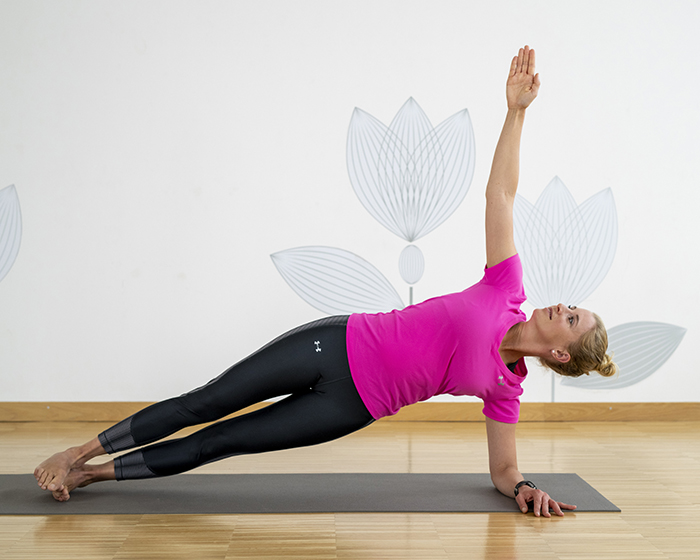
“The second thing I get a lot of benefit from, the more I can feel my muscles and the more I get to know myself, how long it takes me to regenerate and to set new limits, the easier it is for me to make a good training plan for my horses because I know how it feels when the muscles burn and I know that they need a day or two off until the next workout. It’s really helped me so much to get a good feeling of how it is for the horses.”
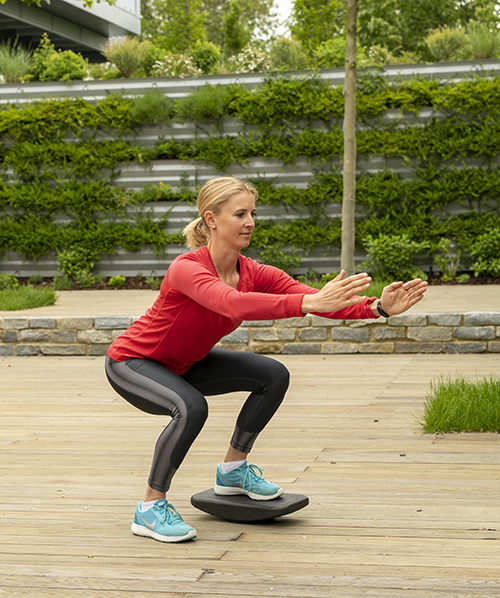
I thought the homework section was a really good idea and how it was presented in the little graph and you could see clearly where you needed to do extra work and the exercises for your own issues that change over the weeks.
“Yes. That makes it more individual and that too is very important to us.”
story continues below the advertisement
Back to Bec and her road test…
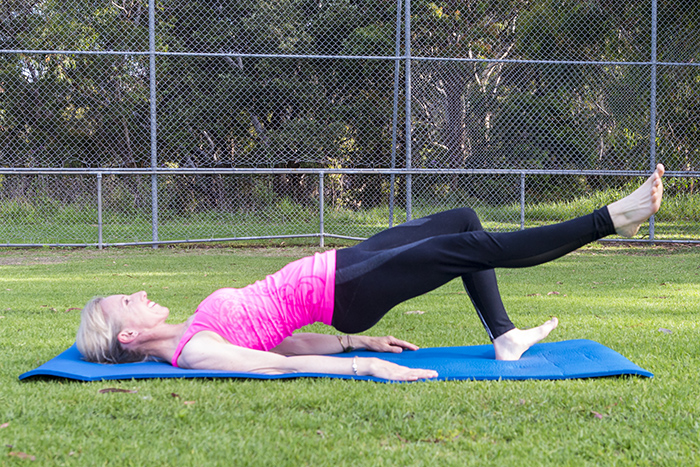
Glute Bridge with Hip Lowering
This is an exercise in one of the first workouts to help strengthen the posterior chain of the body as well as improving hip function. The glute engagement also helps to deactivate the front of the hips. As you hold a bridge with your heels and head and shoulders on the ground, one leg is lifted straight out and the leg raised and lowered with hip rotation.
You used to run a gym, didn’t you?
“Yes. My Dad built a gym for his employees when he had the furniture company. He sold the furniture company in 1998 but he kept the fitness centre and developed it very well. Now it’s more than 2000 square metres and we have over 2000 members. After my studies, I worked there for two years as the manager. At the same time I was trying to become a super rider but after two years I realised that I had to choose.”
And your Mum is a yoga instructor?
“Yes she did a two year yoga instructor qualification and she’s been working and giving lessons for three to four years now and is really into it. She also does all the course plans and management of the yoga studio within the fitness complex.”
No rest for Rebecca
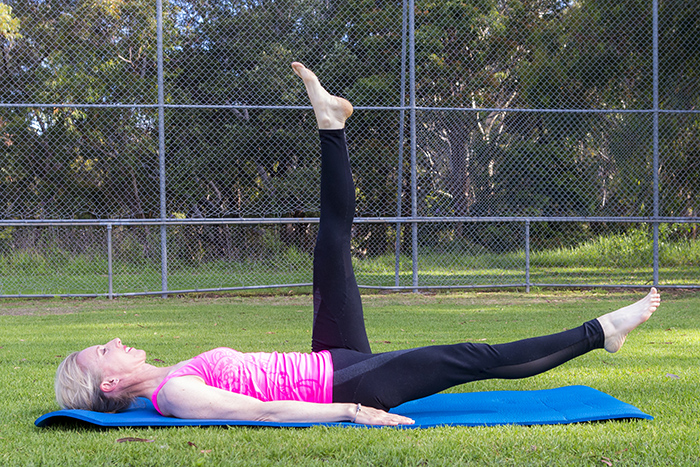
Single Leg Lower
This exercise provides a good core challenge. By lowering one leg at a time, not only does the core get a workout, but its stability is tested by moving the limbs. Moving one leg at a time challenges the body unilaterally. The workout videos provide nots as to what to watch out for and where your body might try to cheat a little.
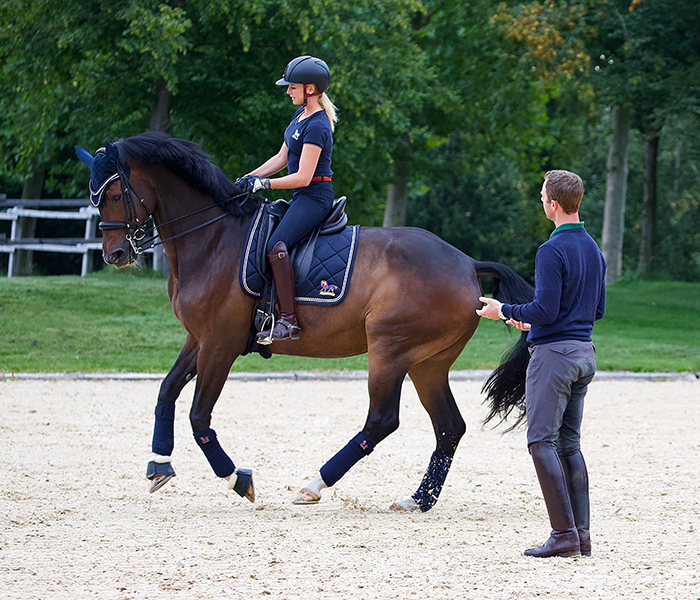 Jessica and brother Benjamin – eyes on the ground…
Jessica and brother Benjamin – eyes on the ground…
What made you realise that riding ten horses a day wasn’t enough or that you had to balance or enhance that work with other fitness work? Was there a moment?
“I realised pretty early that it actually can’t be healthy to only ride because you get very short in your back muscles and the muscles at the back of your legs. So I had to do extra stretching anyway. Also when you ride, you have the inside of your leg very well trained but not the outside of your upper legs. You need to train and balance both agonist and antagonist muscles. If you want to be a healthy, fit rider over many, many years, I think it’s very important to do something. The muscles that you don’t use when you ride need to be worked for balance and it helps decrease pain and prevent injury.”
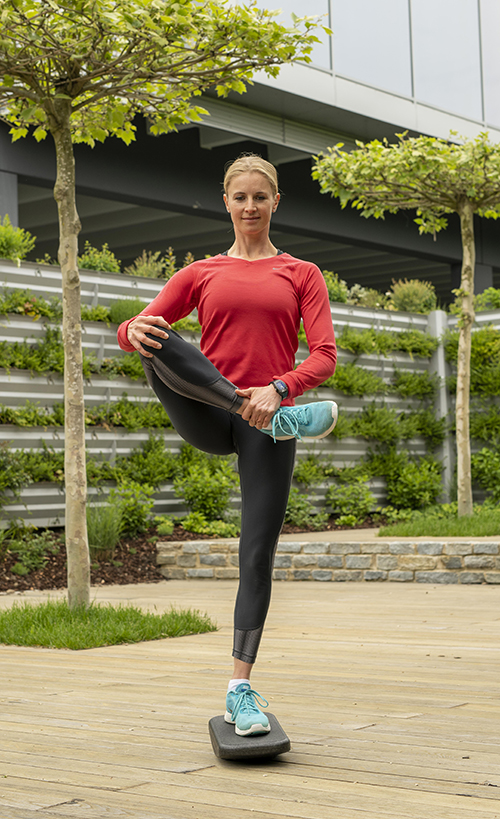
“I think rider fitness is becoming more popular. The horses are becoming more and more athletic so it is more difficult to sit to them properly. Riders feel that need to do something to sit to their horses better. This was actually the reason about 10 years ago I started to do extra fitness. I couldn’t sit Zaire as a young horse properly because she had such impulsion and there were only two options: either I had to trot a little bit smaller so I could sit and make many walk breaks to catch my breath, or I did something for it so I could do it. This was a real eye opener for me.”
Story continues below the advertisement
It’s one thing to exercise but it’s another to have exercises that are transferable to the saddle. So, making the exercise program really functional and related to the particular sport, I think that’s important…
“I think that too. And as you say, doing some exercise is better than doing nothing, but doing the right exercises that really help you and your position is the most efficient way to improve your riding.”
And I guess it takes an expert to know that.
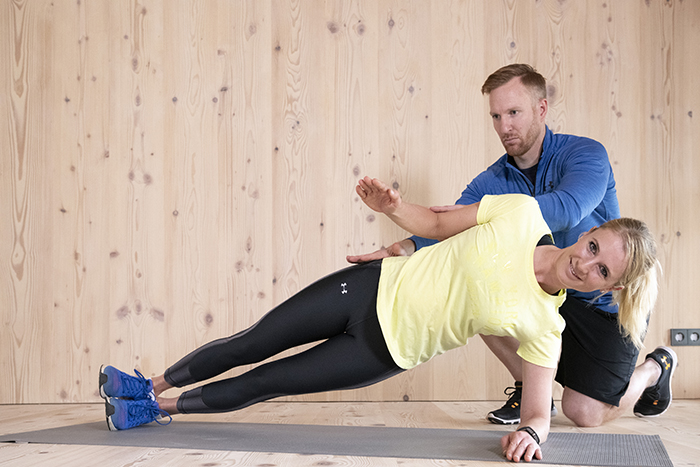
“Yes and my brother and I are not the trainers in this program. We are trained by our coach who is not only a specialist at this but a sports scientist and he’s written books on it. He’s a fitness guru I would say. We were running the fitness centre together then he continued when I left to ride. He’s not doing it now but we kept on with our training together.”
Marcel Andrä, isn’t it?
“Yes. We’ve trained with him for over eight years now. People kept on asking me when they saw on Instagram or Facebook that I was doing extra sport, ‘Hey, can’t you show us your exercises, exactly how you train?’. That’s how the idea was born to share it and make it public so everyone can join and do something for themselves and at the end, we all do it for the horses.”
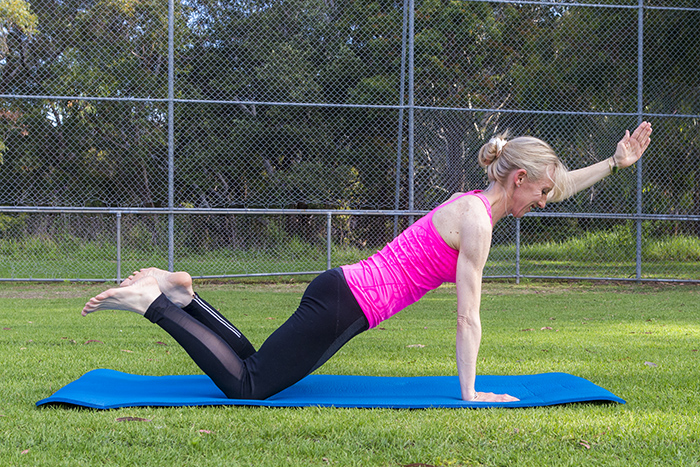
Kneeling Plank with Arm Lift
This is another core stability test but this time off the ground so requires more control from the body. The single arm lift, being a unilateral exercise, adds to the challenge, improves shoulder function and also encourages a dropping of the shoulder blades down the back.
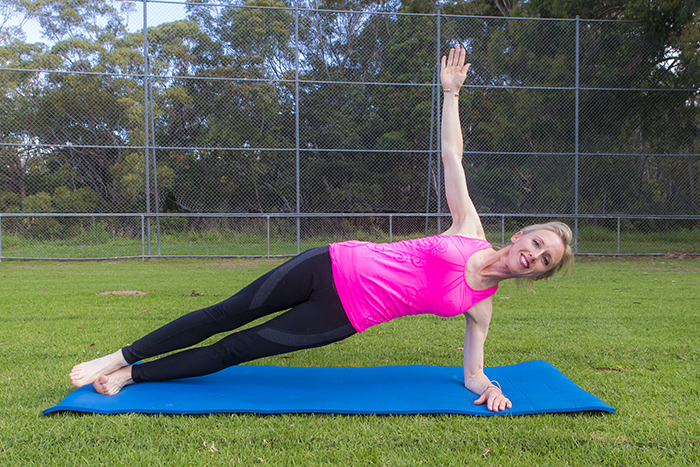
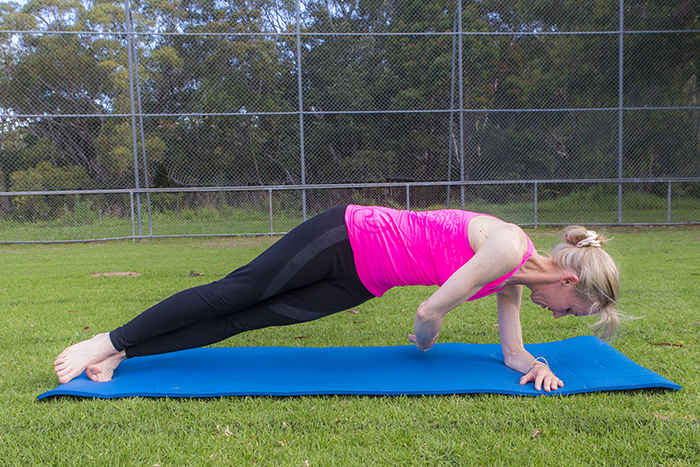
Lateral Plank with Thoracic Spine Rotation
Now we see some lateral work within the plank – and yes, there are plenty of planks in these workouts! The lower side of the body has to work hard to hold you up. Added to this is shoulder stability and making sure that stabilising shoulder doesn’t creep up to visit the ear. Once the side plank is established, the rotation is added to once again test and mobilise the thoracic spine. It ’s often really interesting in this lateral work when you find one side of your body much more able than the other. Don’t be surprised, it’s quite common but also something that should be addressed.
story continues below the advertisement
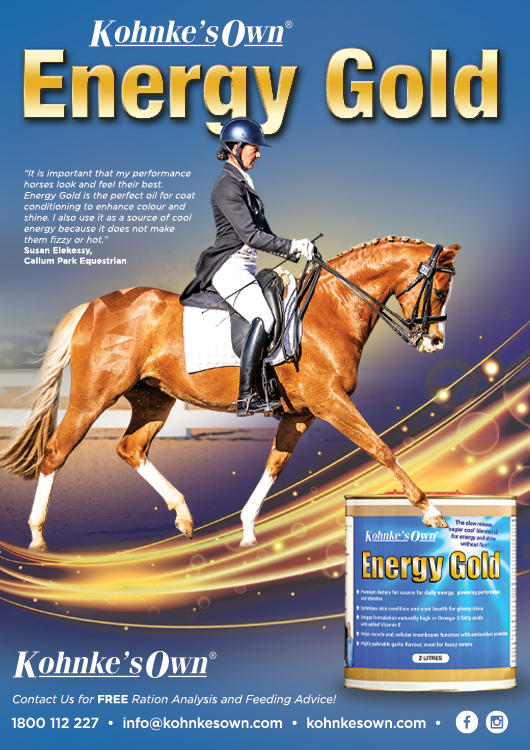
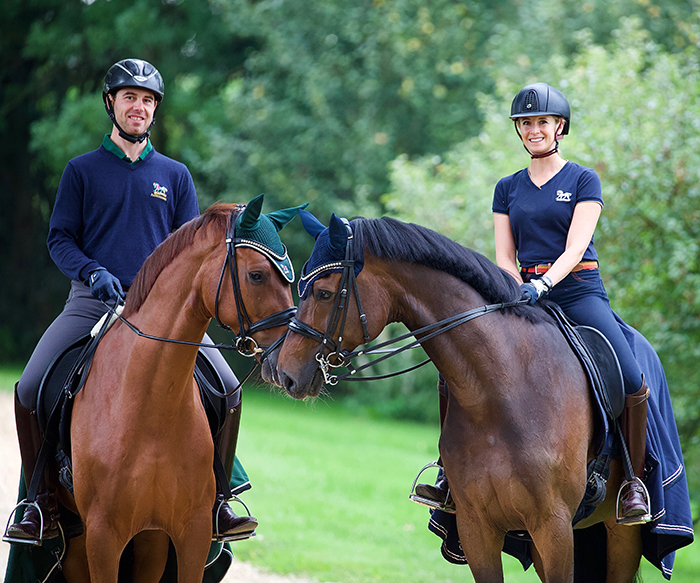
How is your program different to other programs out there that are rider specific? For me, if anything is going to help me ride a tiny bit like you, I’m interested!
“Haha. Actually I don’t have a good comparison. I couldn’t tell you what the big difference is. The only thing I can tell you is that we show exactly how we train and exactly what has helped us to improve our rider position and to help us feel good in our bodies.”
“The feedback has been really positive. The participants really feel a difference. And all the trainers are telling their riders, please do it! And they do it together with us. You don’t feel alone doing it in your living room. We are all in it together.”
With your program, just so people can get a feeling for it, what’s the biggest influence? Would it be yoga or pilates or crossfit style work or a bit of everything?
“Core training plus yoga. Yoga also helps me a lot to connect with my breathing. We all have situations when we are sitting on the horse that we forget to breathe properly and then the horses also stop breathing. Have you felt this? When they’re a bit nervous and you focus on your own breathing, I felt that the horses feel it and they calmed down. This is also a very positive aspect of yoga, the connection to breath.”
And I think people are becoming more aware of that. There are so many more books out there on breathing. I think it’s great it’s become a focus point.
“I think so too.”
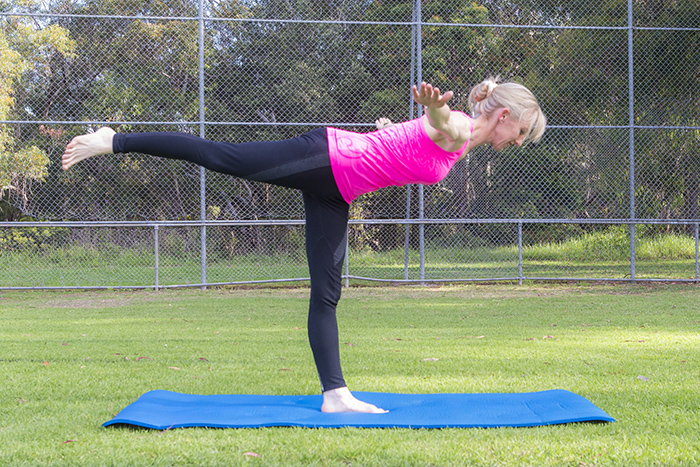
Standing Balance
Not only does this elongate the back of the standing leg, it’s also a great balance exercise and as I’ve said before, good stability comes from good balance! It’s also working the body isometrically, meaning you’re working muscles without actually moving the body. Those little stabilising muscles are working hard to stabilise the joints even though you’re not actually moving. Isometric holds along with dynamic training is important work for horse riders.
What do you think the stand out problems are in riding that this will help? Rough hands, stiff hips?
“For sure riders’ hands that aren’t independent of the rest of the body. If their upper body is shaking, their hands are shaking too. And the stiffness in the hips. They can’t swing in the movement. They can’t go with the movement of the horse and the impulsion. Sometimes they press their knees together to try to be stable but for me it’s like blocking the hips when you do that.”
Getting the stability from balance rather than rigidity. It said somewhere on your website, and I thought it was a really good, concise comment: ‘Absorb, shape and control the horse.’ They’re the three things you have to do as a rider. It’s not all about being softy soft but being in harmony.
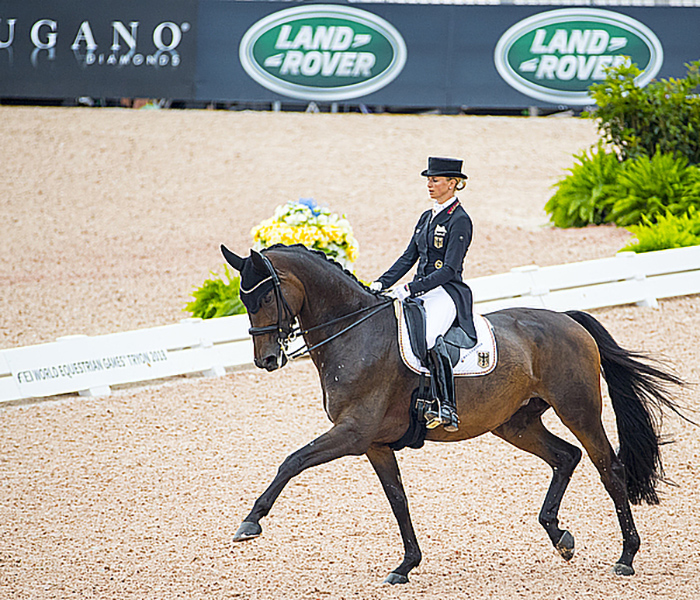
“In harmony and you also need body tension to be able to feel like you’re sitting into the horse’s back; not on the saddle but in the horse. I think that’s the big difference. There are riders that sit on the horse and try to use the whole body tension they have to bump around on the saddle. Then there are riders who look fixed to the horse and they’re really deep in the saddle. They can feel every little movement and go with the movement. I think there’s a big difference.”
And I would add perhaps also knowing that your core is not static but dynamic and ever changing. If you want to be still on something moving you have to move, but with control and well trained motor skills.
“And coordination. There is also coordination in the exercises but not as difficult as if you were in a dance class! Easy to follow but they are there and I think they’re very important to train. It’s a good mixture of everything so you can get a good feeling of your body.”
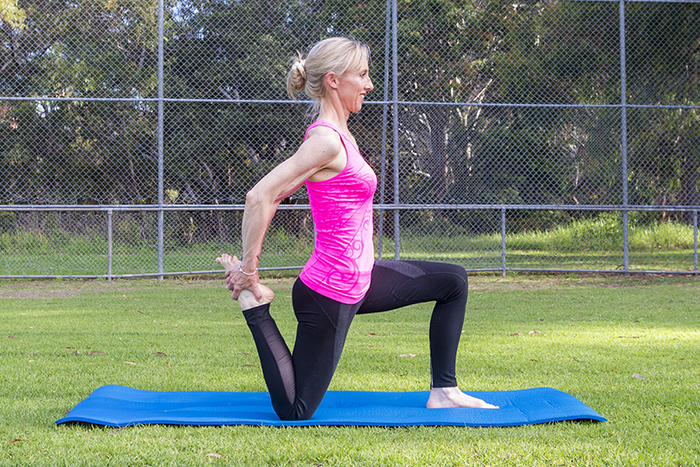
Dynamic Hip Stretch
I like that the stretches are kept a little bit dynamic. There’s no holding and just pulling the leg off, rather there’s a little bit of play within a small range which keeps the muscles online. Riders sometimes get shortened, grabby hips while riding which hinders the ability to swing with the horse. This exercise will help give the body some extra information to help overcome this.
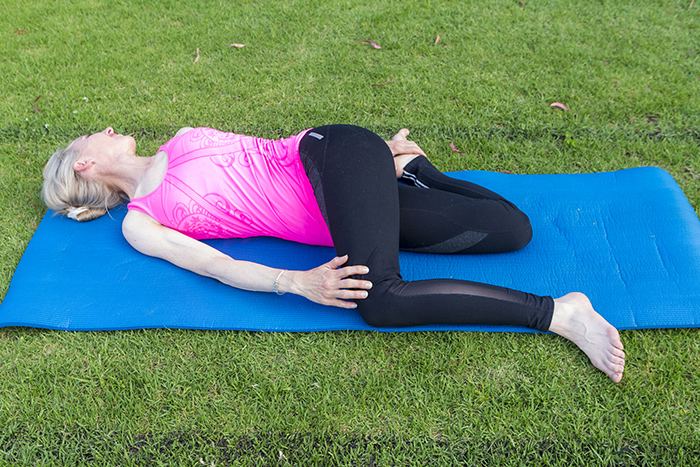
Brettzel Stretch
Is there a better position in the world than the Brettzel Stretch? I’m so glad this is included; it just feels so good! This position targets thoracic mobility with a nice little opener for the lower hip. Again, like the hip flexor stretch, there is a little bit of movement in this position so it isn’t just a passive stretch.
What happens in the program after the 12 weeks?
“You do the 12 weeks within six months. After that you have access to all those exercises plus extra exercises. We have mini workouts if you only have 10 minutes. If you want to have more exercises for the legs, there are classes for that, or core or yoga. If you don’t feel so up for it, you might do a level one workout or some easy yoga exercises. Something is better than nothing. Sometimes we have days like that as well. You get a good feeling for the efficient exercises so you can also mix it up yourself and you’ll get to know the exercises that are best for you. You can have a few days a week where you do nothing, but if you do it two to four times a week, it really makes a difference.”

What do you expect from your team at home?
“We do Dressurfit every week together, either yoga or with Marcel. The riders do it a little bit more often than the grooms. The grooms do it once a week. The riders also do their own workouts of the exercises that are best suited to them on their own.”

“We tend to do the exercises we like most and we keep doing them and they get easier an easier but then we forget other areas of our body! The work never stops. We also keep trying to learn and work on new tests for our Dressurfit members. We just want to share all our experiences, keep it updated and we too keep on learning. It’s so important.”
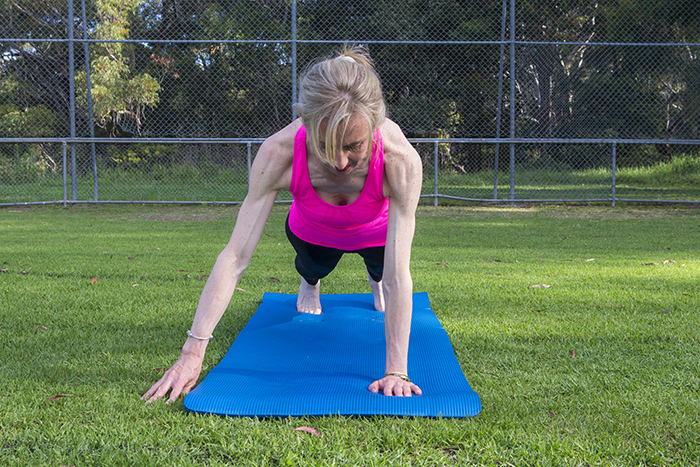
Plank with Side Taps
Holding the plank while lifting one hand and tapping it to the side and back and is another core stability challenge. The hand tap makes it all more functional. Can you move your arm while not moving your body? It’s hard when there’s not a support on each corner! It’s important to keep the plank position and not have the pelvis too high and out of line with the rest of the body.
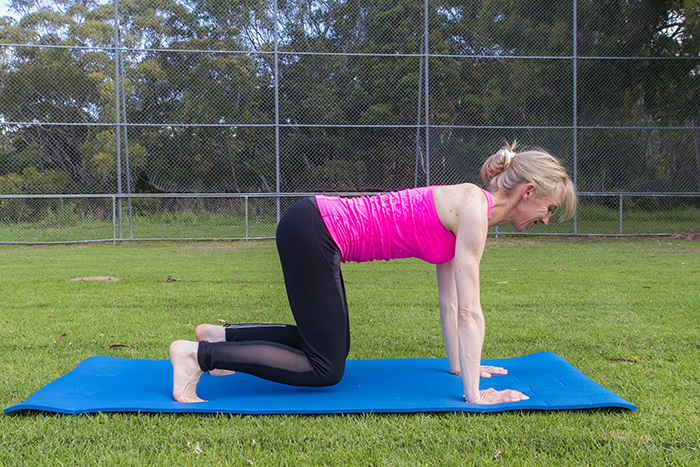
Kneeling to Plank
Kneeling but not kneeling.
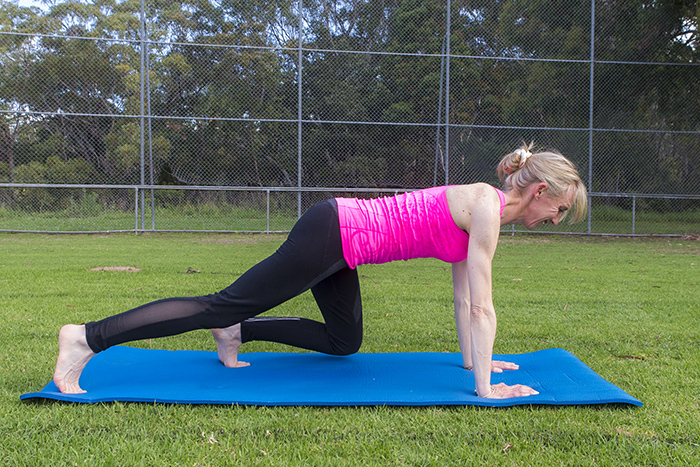
In kneeling to plank, one the knees are hovering just above the ground as you step out into a plank, one foot at a time then back again.
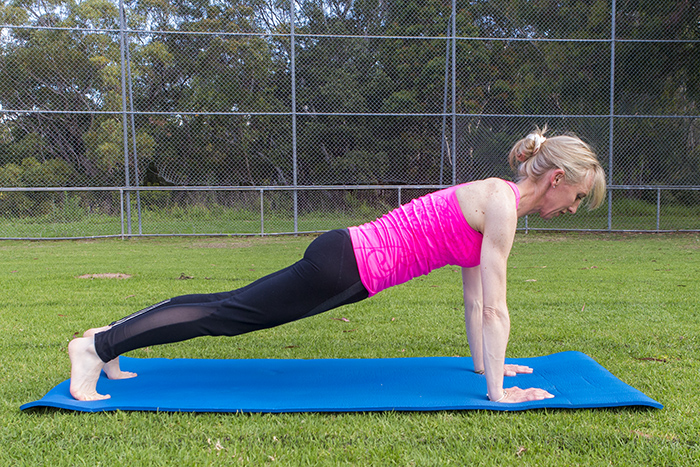
Core strength and stability are tested as you move the legs out and in. Endurance is tested by not touching your knees to the ground. Good luck!
How do the workouts help with the mind and focus under pressure?
“This is an extra topic we are going to do one day; mental strength. It’s not really included in the Dressurfit program. There is a little bit in the Dressurfit workbook if you buy that, something for mental fitness, but we are really focusing on the physical at this point.”
“However for me, I can tell you it has helped me a lot to reflect on my own topics I need to deal with. It helps me so much to have my rituals and I’m always adding something new to my rituals or changing things so I’m always improving my own preparation for competitions. When it comes to pressure, you can have so much pressure from outside, but it is the way we look at ourselves and if we let the pressure dominate us. I always tell myself, well I cannot do more than giving my best. I’m always giving my very best in the arena but I’m not always 100% in the here and now and then I’m a little bit angry with myself.”
“If you think about the things that won’t work or what could happen or go wrong, then you’ve already lost. My goal is always to be focussed, to be connected to my intuition and to believe in myself and to trust myself that I have everything within me that I need now. This helps me to perform.”
Do you do a little workout before you get on to compete?
“Yes, some stretching exercises and to get a little bit of body tension if I’m not nervous enough. I activate myself. At the German Championships, for example, I was so nervous, especially before the Grand Prix Special when I really knew that I could make it. Then it really helped me so much to have my rituals. I hacked Dalera and told her that we’re really going to do it now for us and that we’re going to dance now and we both will just give our very best and that’s all we can do. It really helps me to talk to Dalera and I tell all the horses that I love them independent of the success!”
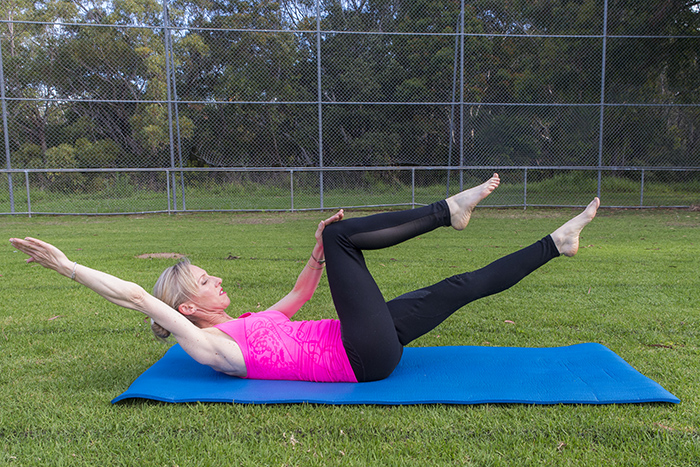 Abdominal Press-diagonal
Abdominal Press-diagonal
Now we have some cross patterning happening. With this one diagonal chain is stabilising while the other is moving. This is one to test the coordination a little bit as well as the opposite arm and leg move long and away from the body then back in again. While obviously not exactly the same, a focus on opposite leg and hand can help the body with ideas and functions such as inside leg to outside hand. It will also help you handle situations such as your shying horse jumping to the side.
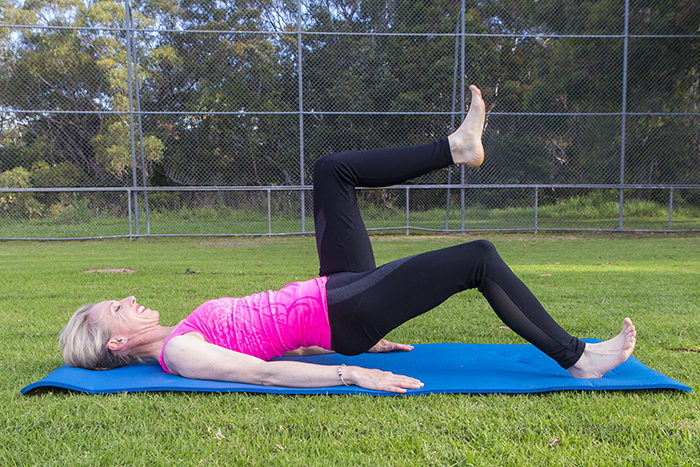
Hip Bridge with Alternating Leg Lift
Another exercise to fire up the back of the body. The single leg lifts not only test your balance, but also your core stability with the added bonus of some hip work as you alternatively lift each leg up into tabletop.
And before we finish, you’re now an author! Tell us about your new book. Is it going to come out in English?

“Yes, but the German publisher needs to deal with that. It’s a very, very honest book. The title sounds a bit boring, but most people are surprised by how honestly I wrote about everything.”
“There’s a saying in Germany, “The luck of the world is on the back of the horse.” So the title is, ‘Das Glück Der Erde’, “The Luck of the World” but the subtitle is, ‘…what I have learnt from my horses.’ It’s not really a biography or a training book, it’s more a reflection of what’s happened so far. It’s a little bit like coaching, but by explaining what I did and how I leant from the different experiences.”
Rebecca’s workout goes on and on…
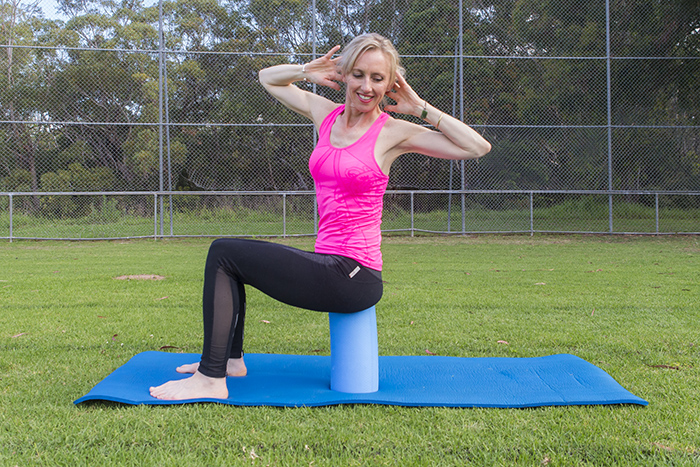
Thoracic Spine Mobilisation
Finally, another of my designated Homework exercises. Rotation of the spine with lateral flexion, rotating further every time. Sitting on the roller brings awareness to your seat bones and if you’re keeping them weighted evenly. It also tests your balance. Jessica can do this much better than me!
My conclusion…
Is rider fitness a phase or is it here to stay? I guess only time will tell but with the sport getting more professional and the younger generation seeming more intent on being athletes and putting it all out there on social media, I’d like to think it’s a new part of riding that’s here to stay. I must admit, I am a bit biased!
There have been a handful of online rider fitness courses over the last few years. While one might argue that any exercise is better than none, personally I’ve tended to shy away from them as I’m a real believer in having a well versed trainer with good eyes to make sure you’re going about things the right way and you’re working in a way that’s beneficial for your unique issues. What you think you’re doing and what you’re actually doing can be quite different! For those of you who aren’t sure about your body awareness and whether you’re executing the exercises well, there are little reminders on screen as to what to watch out for. You might also want to video yourself doing the exercises and compare them to how Jessica, Benni and their team do them. And always make sure you’ve checked with your doctor that you’re fit to exercise if you’re not sure.
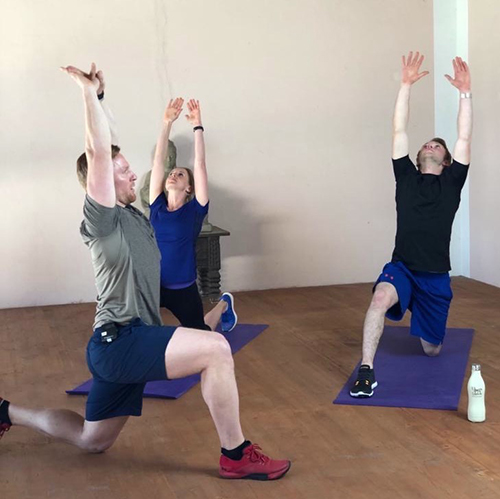
The reason I like this 12 week programme is that it’s designed by a sports scientist with two of the top dressage riders in the world. I also like that it has a personalised test at the start and that you get retested over the course of the series.
Although I’ve only been doing the workouts for a few weeks, I think it’s really true what Jessica says; you tend to do the exercises you like. Confession time, sometimes I do the same, especially when time is short. So, this has been a little bit of a wake up call (and to my clients reading this, do as I say, not as I do!) The little workouts have taken me to a few places that I might have avoided before. We all need to be kept honest sometimes! I’m really enjoying the routines and looking forward to what is in the weeks ahead.
What will I be texting Jessi? My back feels stronger and it’s been really easy to incorporate the exercises into my day. I also feel my endurance has improved, always a good thing when summer is on its way and the weather is hotter and more humid. There have been some really cool variations on a theme, so to speak, that have been a lovely addition to what I already do. Thumbs up!



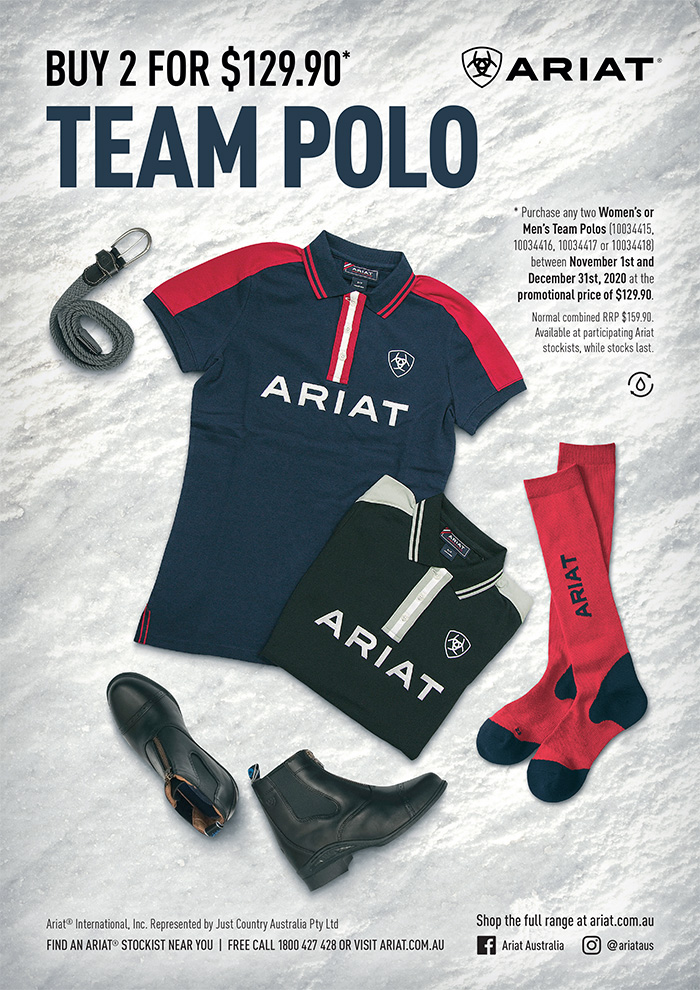
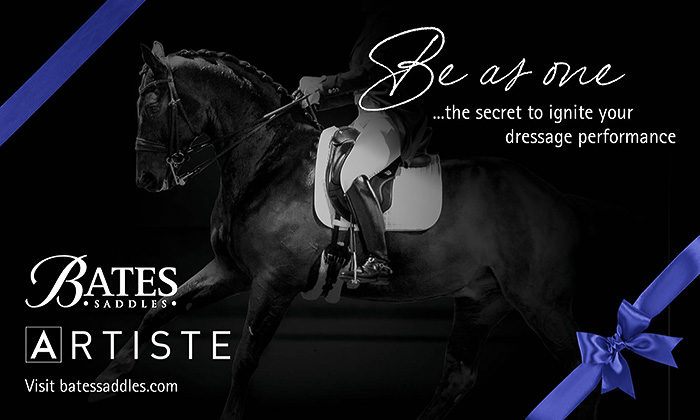

Lovely, motivating and informative article!